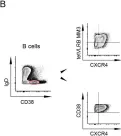Acute myeloid leukemia (AML) remains challenging to cure. In addition to mutations that alter cell functioning, biophysical properties are modulated by external cues. In particular, membrane proteins that interact with the bone marrow niche can induce cellular changes. Here, we develop an atomic force microscopy (AFM) approach to measure non-adherent AML cell mechanical properties. The Young's modulus of the AML cell line, THP-1, increased in response to retronectin, whereas knock-out of the adhesion protein ITGB1 resulted in no response to retronectin. Confocal microscopy revealed different actin cytoskeleton morphologies for wild-type and ITGB1 knock-out cells exposed to retronectin. These results indicate that ITGB1 mediates stimuli-induced cellular mechanoresponses through cytoskeletal changes. We next used AFM to investigate the elastic properties of primary AML cells and found that more committed cells had lower Young's moduli than immature AMLs. Overall, this provides a platform for investigating the molecular mechanisms involved in leukemic cell mechanoresponse.
© 2025 The Author(s).
Product Citations: 74
Elastic properties of leukemic cells linked to maturation stage and integrin activation.
In IScience on 18 April 2025 by Richards, C. J., Wierenga, A. T. J., et al.
In STAR Protocols on 21 June 2024 by Gutch, S., Beasley, L., et al.
Umbilical cord blood (CB) is a donor source for hematopoietic cell therapies. Understanding what drives hematopoietic stem and progenitor cell function is critical to our understanding of the usage of CB in hematopoietic cell therapies. Here, we describe how to isolate and analyze the function of human hematopoietic cells from umbilical CB. This protocol demonstrates assays that measure phenotypic properties and hematopoietic cell potency. For complete details on the use and execution of this protocol, please refer to Broxmeyer et al.1.
Copyright © 2024 The Author(s). Published by Elsevier Inc. All rights reserved.
-
Cardiovascular biology
Children with perinatally acquired HIV exhibit distinct immune responses to 4CMenB vaccine.
In JCI Insight on 11 April 2024 by Cotugno, N., Neri, A., et al.
Children with perinatally acquired HIV (PHIV) have special vaccination needs, as they make suboptimal immune responses. Here, we evaluated safety and immunogenicity of 2 doses of 4-component group B meningococcal vaccine in antiretroviral therapy-treated children with PHIV and healthy controls (HCs). Assessments included the standard human serum bactericidal antibody (hSBA) assay and measurement of IgG titers against capsular group B Neisseria meningitidis antigens (fHbp, NHBA, NadA). The B cell compartment and vaccine-induced antigen-specific (fHbp+) B cells were investigated by flow cytometry, and gene expression was investigated by multiplexed real-time PCR. A good safety and immunogenicity profile was shown in both groups; however, PHIV demonstrated a reduced immunogenicity compared with HCs. Additionally, PHIV showed a reduced frequency of fHbp+ and an altered B cell subset distribution, with higher fHbp+ frequency in activated memory and tissue-like memory B cells. Gene expression analyses on these cells revealed distinct mechanisms between PHIV and HC seroconverters. Overall, these data suggest that PHIV presents a diverse immune signature following vaccination. The impact of such perturbation on long-term maintenance of vaccine-induced immunity should be further evaluated in vulnerable populations, such as people with PHIV.
-
Immunology and Microbiology
In Cell Rep Methods on 18 December 2023 by Manesia, J. K., Maganti, H. B., et al.
Small molecules have enabled expansion of hematopoietic stem and progenitor cells (HSPCs), but limited knowledge is available on whether these agonists can act synergistically. In this work, we identify a stem cell agonist in AA2P and optimize a series of stem cell agonist cocktails (SCACs) to help promote robust expansion of human HSPCs. We find that SCACs provide strong growth-promoting activities while promoting retention and function of immature HSPC. We show that AA2P-mediated HSPC expansion is driven through DNA demethylation leading to enhanced expression of AXL and GAS6. Further, we demonstrate that GAS6 enhances the serial engraftment activity of HSPCs and show that the GAS6/AXL pathway is critical for robust HSPC expansion.
Copyright © 2023 The Authors. Published by Elsevier Inc. All rights reserved.
-
Genetics
-
Stem Cells and Developmental Biology
In Journal of Physiology and Pharmacology : An Official Journal of the Polish Physiological Society on 1 December 2023 by Ye, Q., Ren, L., et al.
This study was designed to explore cryptanshinone (CPT) extract of Salvia miltiorrhiza stimulating pediatric acute myeloid leukemia (AML) stem cell (LSC) apoptosis and anti-inflammatory mechanism via accelerating microRNA (miR)-211-5p to restrain Janus kinase 2 (JAK2)/signal transducer and activator of transcription 3 (STAT3) pathway activation. Obtaining blood samples from pediatric acute myeloid leukemia patients and healthy volunteers and detecting miR-211-5p and JAK2 were performed. Purchase of the human AML cell line KG1a was conducted, and sorting of KG1a cells was to gain LSC. Test of miR-211-5p and JAK2, the phosphorylation of JAK2/STAT3 was implemented. Pretreatment of LSCs was with CPT. Variation of miR-211-5p and JAK2 in LSCs was via plasmid transfection to explore their actions in cell advancement with apoptosis and inflammation. Identification of the targeting of miR-211-5p with JAK2 was implemented. In results: MiR-211-5p was declined in endometrial cancer, while JAK2 was elevated; CPT was available to boost LSC apoptosis and restrain the inflammation; elevated miR-211-5p or repressive JAK2 was available to strengthen the acceleration of CPT on LSCs apoptosis and the repression of inflammation; MiR-211-5p targeted JAK2; augmented JAK2 was available to turn around the action of elevated miR-211-5p. We conclude that CPT extract of Salvia miltiorrhiza stimulated pediatric LSC apoptosis and restrained the inflammation via accelerating microRNA (miR)-211-5p to suppress JAK2/STAT3 pathway activation.
-
Homo sapiens (Human)
-
Biochemistry and Molecular biology
-
Cancer Research
-
Immunology and Microbiology
-
Stem Cells and Developmental Biology
In Cells on 12 April 2020 by Khan, S., Liu, Y., et al.
Fig.5.B

-
FC/FACS
-
Collected and cropped from Cells by CiteAb, provided under a CC-BY license
Image 1 of 1
